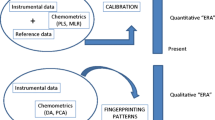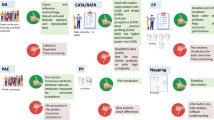Abstract
In the food industry, sensory analysis can be useful to direct marketing decisions concerning not only products, for example product positioning with respect to competitors, but also market segmentation, customer relationship management, advertising strategies and price policies. In this paper we show how interesting information useful for marketing management can be obtained by combining the results from cub models and algorithmic data mining techniques (specifically, variable importance measurements from Random Forest). A case study on sensory evaluation of different varieties of Italian espresso is presented.






Similar content being viewed by others
References
Agresti A (2010) Analysis of ordinal categorical data, 2nd edn. Wiley, NY
Bogue J, Ritson C (2004) Understanding consumers perceptions of product quality for lighter dairy products through the integration of marketing and sensory information. Acta Agr Scand C-Econ 1:67–77
Breiman L (1996) Bagging predictors. Mach Learn 24:123–140
Breiman L (2001) Random forest. Mach Learn 45:5–32
Breiman L, Friedman JH, Olshen RA, Stone CJ (1984) Classification and regression trees. Chapman & Hall, NY
Brentari E, Carpita M, Vezzoli M (2012) CRAGGING: a novel approach for inspecting Italian wine quality. In: Proceedings of the 12th European symposium on statistical methods for the food industry. Agrostat 2012, Paris, pp 343–350
Brentari E, Levaggi R, Zuccolotto P (2011) Pricing strategies for Italian red wine. Food Qual Prefer 22:725–732
Brentari E, Zuccolotto P (2010) The implicit value of chemical and sensorial quality in the hedonic analysis of low-priced Italian red wines. In: Proceedings of the 11th European symposium on statistical methods for the food industry. Agrostat 2010, Benevento, pp 269–276
Brentari E, Zuccolotto P (2011) The impact of chemical and sensory characteristics on the market price of Italian red wines. Electron J Appl Stat An 4:265–276
Cicia G, Corduas M, Del Giudice T, Piccolo D (2010) Valuing consumer preferences with the CUB model: a case study of fair trade coffee. Int J Food System Dynamics 1:82–93
Corduas M, Iannario M, Piccolo D (2009) A class of statistical models for evaluating services and performances. In: Bini M (ed) Statistical methods for the evaluation of educational services and quality of products. Springer, Berlin, pp 99–117
Corduas M, Cinquanta L, Ievoli C (2012) A statistical analysis of consumer perception of wine attributes. Quad Stat 14:77–80
D’Elia A, Piccolo D (2005) A mixture model for preference data analysis. Comput Stat Data An 49:917–934
Everitt BS, Hand DJ (1981) Finite mixture distributions. Chapman & Hall, London
Friedman JH, Popescu BE (2005) Predictive learning via rule ensembles. Technical report, Stanford University, Department of Statistics
Iannario M (2007) A statistical approach for modelling urban audit perception surveys. Quad Stat 9:149–172
Iannario M (2009) Fitting measures for ordinal data models. Quad Stat 11:39–72
Iannario M (2010) On the identifiability of a mixture model for ordinal data. Metron LXVIII:87–94
Iannario M (2012a) Modelling shelter choices in a class of mixture models for ordinal responses. Stat Method Appl 21:1–22
Iannario M (2012b) Preliminary estimators for a mixture model of ordinal data. Adv Data Anal Classif 6:163–184
Iannario M, Piccolo D (2009) A program in cub models inference, Version 2.0. http://www.dipstat.unina.it/CUBmodels1/
Iannario M, Piccolo D (2010) A new statistical model for the analysis of customer satisfaction. Qual Technol Quantit Manag 7:149–168
Iannario M, Piccolo D (2012) CUB models: statistical methods and empirical evidence. In: Kenett RS, Salini S (eds) Modern analysis of customer surveys. Wiley, NY, pp 231–254
Köster EP (2003) The psychology of food choice: some often encountered fallacies. Food Qual Prefer 14:359–373
Köster EP (2009) Diversity in the determinants of food choice: a psychological perspective. Food Qual Prefer 20:70–82
McCullagh P (1980) Regression models for ordinal data (with discussion). J Roy Stat Soc B 42:109–142
McCullagh P, Nelder JA (1989) Generalized linear models. Chapman & Hall, London
McLachlan G, Krishnan T (2008) The EM algorithm and extensions. Wiley, NY
McLachlan G, Peel GJ (2000) Finite mixture models. Wiley, NY
Manisera M, Piccolo D, Zuccolotto P (2011) Analyzing and modelling rating data for sensory analysis in food industry. Quad Stat 13:69–82
Philippe F, Schacher L, Adolphe DC, Dacremont C (2003) The sensory panel applied to textile goods a new marketing tool. J Fash Mark Manag 7:235–248
Piccolo D (2003) On the moments of a mixture of uniform and shifted binomial random variables. Quad Stat 5:85–104
Piccolo D (2006) Observed information matrix for MUB models. Quad Stat 8:33–78
Piccolo D, D’Elia A (2008) A new approach for modelling consumers’ preferences. Food Qual Prefer 19:247–259
Piccolo D, Iannario M (2010) A new approach for modelling consumers’ preferences. In: Proceedings of the 11th European symposium on statistical methods for the food industry. University of Sannio, Benevento, Academy School, Afragola, pp 139–148
Sandri M, Zuccolotto P (2008) A bias correction algorithm for the Gini measure of variable importance. J Comput Graph Stat 17:1–18
Sandri M, Zuccolotto P (2009) Analysis and correction of bias in total decrease in node impurity measures for tree-based algorithms. Stat Comput 20:393–407
Strobl C, Boulesteix A-L, Augustin T (2007) Unbiased split selection for classification trees based on the Gini Index. Comput Stat Data An 52:483–501
Van Trijp HCM, Schifferstein HNJ (1995) Sensory analysis in marketing practice: comparison and integration. J Sens Stud 10:127–147
Zironi R, Odello L, Brentari E (2003) Un nuovo indice per misurare la qualità edonica del vino. Il Sommelier 19:15–17
Acknowledgments
The authors thank Luigi Odello (director of CSA) and Prof. Eugenio Brentari (University of Brescia) for making the data available. The first and third Authors have been partly supported by MIUR project PRIN2008: “Modelling latent variables for ordinal data: statistical methods and empirical evidence” (CUP E61J10000020001), Research Unit at University of Naples Federico II, and by FARO project 2011. M. Iannario benefits of a Fulbright scholarship at Department of Statistics and Actuarial Science, University of Iowa.
Author information
Authors and Affiliations
Corresponding author
Rights and permissions
About this article
Cite this article
Iannario, M., Manisera, M., Piccolo, D. et al. Sensory analysis in the food industry as a tool for marketing decisions. Adv Data Anal Classif 6, 303–321 (2012). https://doi.org/10.1007/s11634-012-0120-4
Received:
Revised:
Accepted:
Published:
Issue Date:
DOI: https://doi.org/10.1007/s11634-012-0120-4




